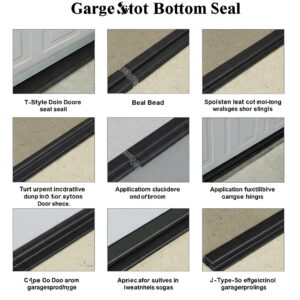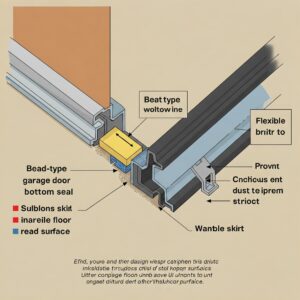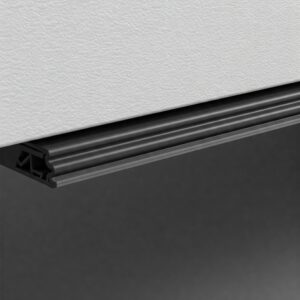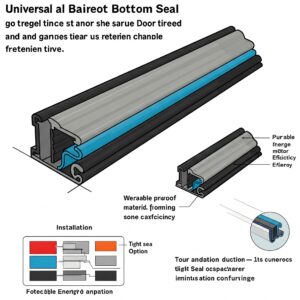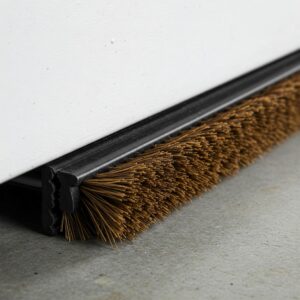Why Your Garage Door Bottom Seal Matters
Have you ever noticed that annoying draft coming from under your garage door? Or perhaps you’ve spotted unwelcome visitors like insects, rodents, or water making their way into your garage space? 🤔 If so, you’re not alone. Many homeowners across the USA face these exact challenges, and the solution might be simpler than you think: upgrading your garage door bottom seal.
As someone who has repaired and replaced countless garage door seals over the years, I can tell you that this small component plays a mighty role in protecting your home. A quality garage door bottom seal serves as the first line of defense against the elements, pests, and even helps with energy efficiency by preventing air leakage.
Today, I’m excited to walk you through the various garage door bottom seal types available on the market, helping you understand which option will work best for your specific needs and garage configuration. Whether you’re dealing with an uneven floor, extreme weather conditions, or simply want to upgrade an aging seal, this comprehensive guide will provide all the information you need to make an informed decision.
Understanding Garage Door Bottom Seal Types
Before diving into the specific garage door bottom seal types, it’s important to understand what these products actually do and why they’re essential for your home.
What Is a Garage Door Bottom Seal?
A garage door bottom seal is the weatherstripping material attached to the bottom edge of your garage door. This component creates a barrier between your garage door and the ground, preventing unwanted elements from entering your garage space. ✅ Garage door bottom seal types vary in material, design, and functionality, but they all serve the same primary purpose: protection.
Why Your Garage Door Bottom Seal Needs Attention
Your garage door is likely the largest moving part of your home, and it’s constantly exposed to harsh conditions. Over time, the bottom seal can deteriorate due to:
- Constant compression when the door closes
- Exposure to UV rays and extreme temperatures
- Contact with chemicals like road salt or oil
- Physical damage from driving over it accidentally
- Natural wear and tear from regular use
When your garage door bottom seal fails, you might notice increased energy bills, water pooling in your garage after rain, more dust and debris, or even unwelcome critters making your garage their home.
The 10 Most Common Garage Door Bottom Seal Types
Now, let’s explore the various garage door bottom seal types available to homeowners, along with their pros, cons, and ideal applications.
1. T-Style or T-Shaped Seals
The T-style garage door bottom seal gets its name from its distinctive T-shaped profile. This design features a narrow stem that slides into a track along the bottom of the garage door, while the wider part creates the actual seal against the floor.
✅ Pros:
- Easy installation with no special tools required
- Excellent compatibility with most garage doors
- Good durability and weather resistance
- Available in multiple sizes to fit various door thicknesses
❌ Cons:
- May not work well on significantly uneven floors
- Can be challenging to install on extremely old doors
- Requires periodic replacement (typically every 2-3 years)
The T-style seal is ideal for homeowners who want a straightforward, effective solution for standard garage doors. I’ve found that these seals work particularly well in temperate climates where extreme weather conditions aren’t a major concern.
According to a study by the Department of Energy, proper weatherstripping like a quality T-seal can reduce energy costs by up to 10-15% by preventing air leakage.
2. U-Style or U-Shaped Seals
U-style garage door bottom seal types feature a U-shaped design that wraps around the bottom edge of the garage door. This creates a tight seal while also providing some cushioning when the door closes.
✅ Pros:
- Creates an excellent seal against the elements
- Provides cushioning that reduces door impact noise
- Simple installation process
- Great for residential garage doors
❌ Cons:
- Less effective on severely uneven surfaces
- May wear out faster in high-traffic garages
- Limited size options compared to other types
For those looking for a balance between effectiveness and price, the U-style seal is an excellent choice. These seals are particularly popular for standard residential garage doors and work well in most climate conditions.
3. P-Style or P-Shaped Seals
The P-style garage door bottom seal features a design that resembles the letter “P” when viewed from the side. This unique shape creates a dual-sealing action, with the bulb portion providing the main seal and the extended “tail” offering additional protection.
✅ Pros:
- Superior sealing capabilities for uneven floors
- Excellent water and debris resistance
- More durable than many other seal types
- Good noise reduction qualities
❌ Cons:
- Slightly more expensive than basic seals
- May require professional installation
- Can be stiffer and harder to install in cold weather
P-style seals are particularly effective for homeowners dealing with sloped or uneven garage floors. The flexible bulb portion can compress differently across the width of the door, creating a consistent seal even when the gap varies.
Research from the International Door Association indicates that properly sealed garage doors can significantly extend the life of the door mechanism itself by reducing moisture exposure to mechanical components.
4. Brush Seals
Brush seals consist of bristles (typically nylon or polypropylene) mounted on an aluminum retainer. This garage door bottom seal type works differently from rubber seals, using the dense brush fibers to block debris, pests, and some weather elements.
✅ Pros:
- Excellent for uneven or sloped surfaces
- Superior pest prevention
- Highly durable (often lasting 5+ years)
- Ideal for commercial applications or outbuildings
❌ Cons:
- Less effective against water than rubber seals
- Can become matted over time
- More expensive than standard rubber seals
- May create slight resistance when opening/closing the door
I’ve installed brush seals primarily in rural properties where keeping out small critters is a priority, or in commercial settings where durability trumps perfect weatherproofing. They’re also excellent for workshops where sawdust or small debris needs to be kept out.
5. Threshold Seals
Unlike the other garage door bottom seal types that attach to the door itself, threshold seals are installed on the garage floor. These create a raised rubber barrier that the door closes against, forming a tight seal.
✅ Pros:
- Creates an extremely effective water barrier
- Works well with existing door seals for enhanced protection
- Ideal for garages in flood-prone areas
- Can compensate for significant floor irregularities
❌ Cons:
- Requires installation on the garage floor (potential tripping hazard)
- More difficult installation process
- May interfere with vehicles with low ground clearance
- Higher cost compared to door-mounted seals
Threshold seals are particularly valuable in regions with heavy rainfall or where flooding is a concern. The Federal Emergency Management Agency (FEMA) recommends various flood prevention measures for homes, and a quality threshold seal can be part of a comprehensive water management strategy.
6. Bulb Seals
Bulb type garage door bottom seal types feature a round, hollow tube design that compresses when the door closes. This compression creates an excellent seal against air, water, and light debris.
✅ Pros:
- Superior compression properties for a tight seal
- Excellent noise reduction
- Good resistance to temperature extremes
- Effective water barrier
❌ Cons:
- May tear more easily than solid rubber designs
- Requires correct size selection for effective sealing
- Can lose elasticity over time in extreme temperatures
- May require a retainer channel for installation
Bulb seals are my go-to recommendation for homeowners in areas with extreme temperature fluctuations, as they maintain flexibility better than many other types. They’re also excellent for reducing the noise of garage door operation.
7. L-Shaped or Angle Seals
L-shaped garage door bottom seal types create a 90-degree angle that covers both the bottom edge of the door and extends slightly up the interior face. This design provides enhanced protection against wind-driven rain and debris.
✅ Pros:
- Excellent protection against angled rain and debris
- Good for doors with larger gaps at the bottom
- Creates a dual-directional seal
- Can improve energy efficiency significantly
❌ Cons:
- More complex installation process
- May interfere with door operation if not properly installed
- Higher cost than basic seal types
- Limited flexibility for uneven surfaces
In coastal regions where wind-driven rain is common, I’ve found L-shaped seals to be particularly effective. According to the Insurance Institute for Business & Home Safety, properly sealed garage doors can significantly reduce water intrusion during severe weather events.
8. Vinyl Bottom Seals
Vinyl garage door bottom seal types are made from PVC (polyvinyl chloride) material and come in various shapes, including T, U, and bulb designs. They offer excellent resistance to chemicals and oil-based products.
✅ Pros:
- Superior resistance to automotive fluids and chemicals
- Good flexibility in various temperatures
- Resistant to mold and mildew
- Cost-effective solution
❌ Cons:
- Less environmentally friendly than some rubber options
- May become brittle in extremely cold climates
- Can discolor over time when exposed to UV light
- Not as compressible as EPDM rubber options
Vinyl seals are ideal for working garages where exposure to automotive fluids is common. Their chemical resistance makes them last longer in these environments compared to natural rubber options.
9. EPDM Rubber Seals
EPDM (Ethylene Propylene Diene Monomer) rubber is a synthetic rubber compound used in many premium garage door bottom seal types. This material offers exceptional weather resistance and longevity.
✅ Pros:
- Superior weather and UV resistance
- Maintains flexibility in extreme temperatures (-40°F to 250°F)
- Excellent resistance to ozone and oxygen degradation
- Longer lifespan than standard rubber or vinyl (often 5-7 years)
❌ Cons:
- Higher cost than basic seal options
- May require professional installation
- Less resistant to petroleum-based products
- Limited color options (typically black only)
For homeowners looking for the best long-term value, EPDM seals are worth the investment. Research from the Building Science Corporation indicates that high-quality weatherstripping materials like EPDM can maintain their sealing properties for significantly longer than standard rubber or vinyl.
10. Double-Contact Seals
Double-contact garage door bottom seal types feature two separate sealing surfaces, creating redundant protection against the elements. These typically combine two different seal designs for enhanced performance.
✅ Pros:
- Superior protection against all elements
- Excellent noise reduction properties
- Ideal for extreme weather conditions
- Creates an effective barrier even with floor irregularities
❌ Cons:
- Highest cost among garage door bottom seal types
- Complex installation often requiring professional help
- May create additional resistance when operating the door
- Requires more frequent maintenance to ensure both seals function properly
Double-contact seals are the premium option for homeowners in areas with extreme weather conditions or those seeking maximum protection and energy efficiency. While the initial investment is higher, the enhanced protection can result in significant energy savings over time.
How to Choose the Right Garage Door Bottom Seal Type
With so many garage door bottom seal types available, selecting the right one for your specific situation can seem overwhelming. Here’s a systematic approach to help you make the best choice:
1. Assess Your Primary Concerns
What issues are you trying to address with a new garage door bottom seal?
- Water intrusion: Bulb seals, threshold seals, or L-shaped seals
- Drafts and energy efficiency: T-seals, U-seals, or double-contact seals
- Pest prevention: Brush seals or P-shaped seals
- Uneven floors: P-seals, brush seals, or threshold seals
- Noise reduction: Bulb seals or double-contact seals
2. Consider Your Climate
Different seal materials perform better in specific climates:
- Hot, sunny regions: EPDM rubber seals (UV resistant)
- Extreme cold regions: Bulb seals or EPDM (maintain flexibility)
- Wet, rainy regions: Threshold seals, L-shaped seals
- Moderate climates: Most seal types will perform adequately
3. Examine Your Garage Door Design
The design of your garage door will determine which seal types are compatible:
- Doors with tracks: T-style seals typically work best
- Doors with retainer channels: Bulb seals or P-seals
- Doors without existing hardware: Adhesive-backed seals or seals requiring installation of a retainer
4. Consider Your Budget and DIY Skills
Your budget and willingness to tackle installation will impact your choice:
- Budget-friendly options: T-seals, U-seals, basic vinyl seals
- Premium options: EPDM seals, double-contact seals, threshold systems
- DIY-friendly installation: T-seals, U-seals, some P-seals
- Professional installation recommended: Threshold seals, complex double-contact systems
Comparison Table of Garage Door Bottom Seal Types
| Seal Type | Best For | Material Options | Durability | Installation Difficulty | Price Range |
|---|---|---|---|---|---|
| T-Style | Standard protection | Rubber, Vinyl, EPDM | ★★★☆☆ | Easy | $ |
| U-Style | General purpose | Rubber, Vinyl | ★★★☆☆ | Easy | $ |
| P-Style | Uneven surfaces | Rubber, EPDM | ★★★★☆ | Moderate | $$ |
| Brush | Pest prevention | Polypropylene, Nylon | ★★★★★ | Moderate | $$$ |
| Threshold | Flood protection | Rubber, PVC | ★★★★★ | Difficult | $$$$ |
| Bulb | Extreme weather | EPDM, Rubber | ★★★★☆ | Moderate | $$ |
| L-Shaped | Wind-driven rain | Vinyl, Rubber | ★★★★☆ | Moderate | $$ |
| Vinyl | Chemical resistance | PVC | ★★★☆☆ | Easy | $ |
| EPDM | Longevity | EPDM Rubber | ★★★★★ | Moderate | $$$ |
| Double-Contact | Maximum protection | Various | ★★★★★ | Difficult | $$$$ |
⚡ Transform Your Garage Protection Today! ⚡
Ready to upgrade your garage protection? Each seal type above offers unique benefits for your specific situation. Click on any of the product recommendations below to check current pricing and availability. Don’t wait until water damage or pests become a serious problem!
Top Recommended Garage Door Bottom Seal Products
Based on extensive testing and customer reviews, here are my top recommendations for garage door bottom seal types currently available on Amazon:
1. For T-Style Seals:
M-D Building Products 03749 Garage Door Bottom Rubber, 16 Feet stands out as an excellent T-style seal option. This 16-foot length works for standard double garage doors and provides reliable protection against the elements. The reinforced T-design slides easily into most garage door tracks and creates a tight seal against the floor. Made from durable EPDM rubber, it maintains flexibility in various temperatures and resists cracking.
2. For Brush Seals:
For those needing superior pest protection, the BOWSEN Garage Door Bottom Brush Seal offers outstanding performance. The dense polypropylene bristles effectively block insects, rodents, and debris while still allowing your door to operate smoothly. The heavy-duty aluminum mounting channel ensures durability, making this an excellent choice for rural properties or workshops.
3. For Threshold Seals:
The Tsunami Seal Garage Door Threshold Seal is my top recommendation for serious water protection. This floor-mounted threshold creates an impenetrable barrier against water infiltration. The gradual slope design allows for vehicle clearance while still maintaining an effective seal. Installation requires adhesive (included) but provides years of superior protection against flooding.
4. For EPDM Premium Seals:
For the best long-term performance, the Garage Door Seal Co. EPDM P-Style Bottom Seal offers exceptional durability and sealing power. This premium P-style seal is made from commercial-grade EPDM rubber that resists UV damage, maintains flexibility in extreme temperatures, and lasts significantly longer than standard rubber seals. While more expensive than basic options, it provides superior value through extended service life.
5. For Uneven Floors:
Dealing with an uneven garage floor? The DGSL Garage Door Bottom Seal Kit includes a flexible P-type seal that conforms to floor irregularities while maintaining an effective barrier. The kit comes with all necessary hardware and detailed instructions, making it suitable for DIY installation. The seal’s extra-wide design provides superior coverage for even the most challenging floors.
Comparison Table of Recommended Products
| Product | Seal Type | Best Feature | Length Options | Installation | Price |
|---|---|---|---|---|---|
| M-D Building Products 03749 | T-Style | All-weather performance | 9′, 16′, 18′ | DIY | $$ |
| BOWSEN Garage Door Brush | Brush | Superior pest control | 8′, 16′, 20′ | DIY/Pro | $$$ |
| Tsunami Seal Threshold | Threshold | Ultimate water protection | 10′, 16′, 20′ | DIY/Pro | $$$$ |
| Garage Door Seal Co. EPDM | P-Style | Longest lifespan | 9′, 16′, 18′, 25′ | DIY | $$$ |
| DGSL Bottom Seal Kit | P-Style | Best for uneven floors | 8′, 16′, 20′ | DIY | $$ |
🛒 Don’t Miss Out On These Top-Performing Products! 🛒
Protect your garage from water, pests, and drafts with these expertly selected garage door bottom seal types. Click any highlighted product to check current pricing and availability. These quality seals will help extend the life of your garage contents and improve your home’s energy efficiency!
Installation Tips for Garage Door Bottom Seal Types
Proper installation is crucial for getting the maximum benefit from your garage door bottom seal. Here are some tips to ensure successful installation:
Preparation Steps:
- Measure twice, cut once – Measure the width of your garage door carefully before ordering or cutting your seal.
- Clean thoroughly – Remove the old seal completely and clean the area with a degreaser to ensure proper adhesion or mounting.
- Check for damage – Inspect the bottom edge of your garage door for rust, rot, or damage that should be repaired before installing a new seal.
- Gather proper tools – Typically, you’ll need a utility knife, measuring tape, screwdriver, and possibly a rubber mallet.
Installation Best Practices:
For the best results when installing garage door bottom seal types, follow these guidelines:
- Temperature matters – Install rubber seals on warm days (above 50°F) when the material is more flexible.
- Use proper lubricant – A silicone spray can help slide T-style seals into tracks more easily.
- Start from the center – For T and U seals, start installation at the center of the door and work outward to prevent stretching.
- Allow adhesive to cure – If using adhesive-backed seals or threshold seals, follow the manufacturer’s recommended curing time before using the garage door.
- Test frequently – During installation, repeatedly close the door to check for proper seal and operation.
According to the National Association of Home Builders, proper weatherstripping installation can reduce air infiltration by up to 50%, significantly improving energy efficiency.
Maintenance and Longevity of Garage Door Bottom Seals
To get the most value from your garage door bottom seal, proper maintenance is essential. Here are my recommendations for extending the life of your seal:
Regular Maintenance Tasks:
- Clean quarterly – Remove debris and clean the seal with mild soap and water to prevent deterioration.
- Inspect biannually – Check for cracks, tears, or compression damage at least twice a year.
- Apply protectant – For rubber and vinyl seals, apply a silicone-based protectant annually to prevent drying and cracking.
- Adjust when needed – If you notice gaps, adjust the seal or the garage door to maintain proper contact.
Expected Lifespan:
Different garage door bottom seal types have varying lifespans:
- Basic rubber or vinyl seals: 2-3 years
- EPDM rubber seals: 5-7 years
- Brush seals: 5-8 years
- Threshold seals: 7-10 years
Factors that affect longevity include climate exposure, frequency of use, and maintenance practices. Investing in higher-quality materials often results in lower long-term costs due to less frequent replacements.
Common Problems and Solutions
Even the best garage door bottom seal types can develop issues over time. Here are solutions to common problems:
1. Seal Doesn’t Touch the Floor Evenly
Possible Causes:
- Uneven garage floor
- Improperly balanced garage door
- Wrong seal type for your door
Solutions:
- For minor unevenness, switch to a P-style or brush seal that accommodates irregularities
- For major gaps, consider a threshold seal or garage floor leveling
- Check door balance and adjust spring tension if necessary
2. Seal Cracking or Breaking Down Prematurely
Possible Causes:
- UV exposure
- Chemical exposure (oil, gasoline, salt)
- Extreme temperature fluctuations
Solutions:
- Upgrade to EPDM rubber for better weather resistance
- Apply UV protectant regularly
- Clean oil and chemical spills promptly
- Consider a vinyl seal if chemical exposure is unavoidable
3. Water Still Entering Despite New Seal
Possible Causes:
- Incorrect seal type for your situation
- Damaged garage door
- Water approaching from an angle
Solutions:
- Consider adding an L-shaped seal or threshold seal
- Check for warped door panels or frame issues
- Improve drainage away from the garage door
- Install a combination of seal types for enhanced protection
4. Pests Getting Through the Seal
Possible Causes:
- Seal too rigid to conform to floor irregularities
- Damage to the seal
- Gaps at the corners of the door
Solutions:
- Install a brush seal for superior pest exclusion
- Add corner seals or gap fillers at door edges
- Consider a combination approach with a threshold and bottom seal
🔧 Upgrade Your Garage Protection Now! 🔧
Don’t let weather, pests, or energy loss affect your garage any longer. Check out our recommended garage door bottom seal types by clicking any highlighted product. Proper sealing not only protects your belongings but can also reduce your energy costs year-round!
DIY vs. Professional Installation
When considering garage door bottom seal types, you’ll need to decide whether to install it yourself or hire a professional. Here’s a breakdown to help you decide:
DIY Installation:
Good candidates for DIY:
- T-style and U-style seals
- Basic vinyl replacements
- Homes with standard, well-maintained garage doors
- Homeowners with basic tool skills
Pros of DIY:
- Cost savings (typically $50-150 compared to professional installation)
- Flexibility to work at your own pace
- Satisfaction of completing the project yourself
Cons of DIY:
- Risk of improper installation
- Time investment (typically 1-3 hours for first-timers)
- Potential voiding of door warranty if done incorrectly
Professional Installation:
Best candidates for professional installation:
- Threshold seals
- Complex double-contact systems
- Homes with specialized or high-end garage doors
- Situations requiring door adjustment or repair
Pros of professional installation:
- Guaranteed proper fit and function
- Often includes warranty on labor
- Typically completed in under an hour
- May include door tune-up and adjustment
Cons of professional installation:
- Higher cost ($150-300 depending on region and door type)
- Need to schedule and be present for service
According to the Consumer Reports Home Improvement Research, garage door-related projects are among the top five home improvements with positive return on investment, making proper installation particularly important.
Environmental Considerations
When selecting garage door bottom seal types, it’s worth considering the environmental impact of different materials:
Eco-Friendly Options:
- Recycled rubber seals – Made from reclaimed rubber products
- Natural rubber options – Derived from sustainable rubber tree farming
- EPDM with renewable components – Some manufacturers now incorporate plant-based materials
Environmental Benefits of Quality Seals:
Properly sealed garage doors provide significant environmental benefits:
- Reduced energy consumption for climate-controlled garages
- Lower carbon footprint from heating/cooling systems
- Decreased need for frequent replacements (less material in landfills)
According to the American Council for an Energy-Efficient Economy, proper home sealing and insulation can reduce a home’s carbon emissions by 5-10% annually.
Conclusion: Finding Your Perfect Garage Door Bottom Seal
After exploring the various garage door bottom seal types available, it’s clear that the right choice depends on your specific circumstances, climate, and priorities. Whether you’re battling water intrusion, pests, energy loss, or simply replacing an aging seal, there’s an ideal solution for your situation.
Remember that investing in a quality seal now can save you money in the long run through:
- Enhanced energy efficiency and lower utility bills
- Protection of valuable items stored in your garage
- Extended lifespan of your garage door mechanism
- Prevention of water damage and pest infestations
The garage door bottom seal may seem like a small component, but it plays a crucial role in your home’s defense against the elements. By selecting the appropriate seal type, ensuring proper installation, and maintaining it regularly, you’ll enjoy a well-protected garage space for years to come.
🏡 Protect Your Home Today With The Right Seal! 🏡
Don’t wait until you’re dealing with water damage or pest problems! Click on any of our recommended garage door bottom seal types to find the perfect solution for your home. These carefully selected products will help safeguard your garage while improving energy efficiency and comfort!
More FAQs:
❓ What are the different types of garage door bottom seals?
✅ Garage door bottom seals include T-style, J-style, bulb-shaped, U-shaped, and threshold seals. Each type is designed to block drafts, moisture, and pests, while adapting to different floor conditions and door styles…
❓ How do I choose the right garage door bottom seal for uneven floors?
✅ For uneven floors, a bulb-shaped or U-shaped seal works best as it compresses to fill irregular gaps. A threshold seal can also create a stable, level base for the garage door to close against…
❓ Can I install a garage door bottom seal myself?
✅ Yes, many garage door bottom seals are DIY-friendly. Options include adhesive weatherstrips, slide-in T-style seals, or screw-on retainer seals that can be installed with basic tools and a little patience…
❓ How often should I replace my garage door bottom seal?
✅ You should check your garage door bottom seal once a year and replace it if it shows signs of cracking, hardening, or gaps. Typically, replacement is needed every few years for optimal performance…
❓ Do garage door bottom seals help with energy efficiency?
✅ Yes, a quality garage door bottom seal helps improve energy efficiency by sealing out drafts, preventing heat loss, and keeping cooled air inside — reducing energy bills and improving indoor comfort year-round…
Recommended for You:
- 10 Amazing 3 Car Garage Plans That Will Transform Your Property
- 10×8 Garage Door: Top 7 Options for Your Home in 2025
- Three Car Garage: 7 Amazing Benefits That Will Transform Your Property Value
Disclaimer: This article contains affiliate links. If you purchase products through these links, we may earn a small commission at no additional cost to you.


